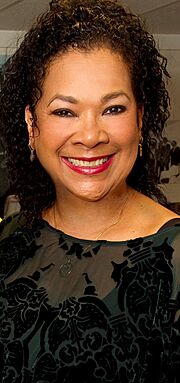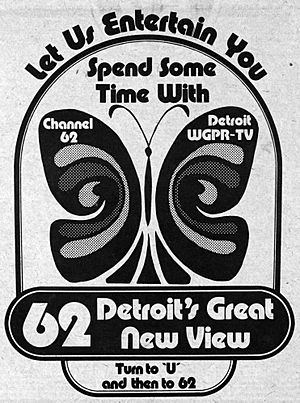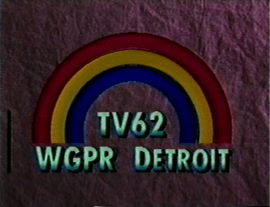WWJ-TV facts for kids
| Detroit, Michigan United States |
|
|---|---|
| Channels | Digital: 21 (UHF) Virtual: 62 |
| Branding | CBS Detroit; CBS News Detroit |
| Programming | |
| Affiliations |
|
| Ownership | |
| Owner | CBS News and Stations (CBS Broadcasting Inc.) |
|
Sister stations
|
WKBD-TV |
| History | |
|
First air date
|
September 29, 1975 |
|
Former call signs
|
WGPR-TV (1973–1995) |
|
Former channel number(s)
|
|
|
Former affiliations
|
Independent (1975–1994) |
|
Call sign meaning
|
derived from former sister station WWJ radio |
| Technical information | |
|
Licensing authority
|
FCC |
| Facility ID | 72123 |
| ERP | 380 kW |
| HAAT | 326.7 m (1,072 ft) |
| Transmitter coordinates | 42°26′52.5″N 83°10′23.1″W / 42.447917°N 83.173083°W |
| Links | |
|
Public license information
|
Profile LMS |
WWJ-TV (channel 62) is a television station in Detroit, Michigan, United States. It is owned by the CBS television network. The station shares its studios with WKBD-TV (channel 50) in Southfield. WWJ-TV's transmitter is located in Oak Park, Michigan.
The station started as WGPR-TV in 1975. It was founded by William V. Banks and the International Free and Accepted Modern Masons. This made channel 62 the first Black-owned television station in the mainland United States. WGPR-TV aimed to create programs for the Black community. It also had its own news team. Many Black television hosts and executives started their careers here. These include Pat Harvey, Shaun Robinson, Sharon Dahlonega Bush, and Amyre Makupson. The original WGPR-TV studios are now a museum. They are also a historical landmark.
In 1994, CBS needed a new station in Detroit. They bought WGPR-TV and changed its name to WWJ-TV the next year. The station then started showing CBS programs. For many years, WWJ-TV did not have much local news. It mostly showed network programs. However, in January 2023, a full news department called CBS News Detroit began. It is part of CBS News's streaming service.
Contents
Early Days of Channel 62
Before WGPR-TV
Channel 62 in Detroit was first used by WXON-TV. This station started broadcasting on September 15, 1968. WXON-TV operated on channel 62 for four years. In 1972, WXON-TV moved to channel 20. This left channel 62 open for a new station.
How WGPR-TV Started
After channel 62 became available, W.G.P.R., Inc. applied to use it. This company owned WGPR (107.5 FM) radio. The Federal Communications Commission (FCC) approved their request in May 1973. W.G.P.R., Inc. was owned by the International Free and Accepted Modern Masons. This group was for Black members.
Dr. William V. Banks founded the Masons in 1950. WGPR-FM was one of the few Black-owned radio stations in Detroit. Banks wanted the TV station to focus on the Black community. He said it would show the "problems, goals, aspirations and achievements of Blacks". This was important because Black people watched a lot of television.
Building the station took almost two years. It was hard to get money to start it. But in 1975, the Masons sold some property to help pay for it. The station began broadcasting on September 29, 1975. President Gerald R. Ford and Senator Robert P. Griffin sent greetings. President Ford called WGPR "a symbol of successful Black enterprise".
WGPR-TV's Local Programs
Focusing on Detroit's Community
WGPR-TV started with a goal to serve the Black community. There were not many Black people on TV at the time. James Panagos, the station's sales vice president, even started a school to train Black TV sales professionals. The station got advertising from big companies like automakers and department stores.
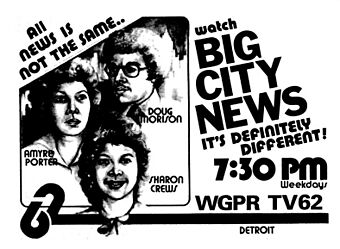
The station had few syndicated shows with Black actors. So, channel 62 made many of its own programs. They planned shows like a soap opera, a morning show, and a children's show. About 90 percent of WGPR-TV's schedule was local shows. This was very unusual for a TV station. Bill Humphries hosted Speaking of Sports, which covered local and high school sports.
One very popular show was The Scene. It was a live dance music program. It was like American Bandstand or Soul Train. Famous musicians like James Brown and Prince appeared on the show. Pat Harvey started as a sales assistant and became a fill-in host for The Scene. She later became a very successful news anchor in Chicago and Los Angeles.
WGPR-TV also had a news department called Big City News. It aimed to cover stories important to Detroit's urban population. It focused on positive stories about the Black community. Sharon Crews was the first weather presenter. Amyre Makupson also started her career in the news department. She later became a well-known anchor for WKBD-TV. WGPR-TV was the first in Detroit to use videotape for news.
Challenges and Changes
The station faced many difficulties early on. Technical problems were common. They had to cut back on broadcast hours and planned programs. WGPR-TV also struggled to attract viewers and advertisers. Some companies even pulled their ads because of equipment issues.
The news department was reduced in size. Many planned shows never aired. The station lost a lot of money in its first year. Equipment was old and sometimes broke down. For example, a thunderstorm damaged the transmitter in 1976.
To stay afloat, WGPR-TV started selling airtime to religious ministries. The PTL Club was one popular religious program. Different ethnic groups also bought airtime. Shows like Arab Voice of Detroit, Dino's Greece, and Polish Panorama were added. This helped the station financially.
In 1977, WGPR-TV became the first station in Detroit to broadcast 24 hours a day. They added all-night movies. Ron "The Ghoul" Sweed brought his horror/comedy show to the station for a short time. Black Film Showcase showed movies starring Black actors. By 1983, after eight years, channel 62 finally started making a profit. It offered over 60 hours of local programming each week.
After William V. Banks
William V. Banks passed away in August 1985. His death led to some disagreements within the Masons. The station received offers to buy it, but no sale happened. WGPR-TV was not getting many viewers, but it was still making a good profit.
In 1987, The Scene was replaced by Contempo, a similar dance music show. The New Dance Show also started in 1988. It focused on newer music like techno and house. R.J. Watkins produced and hosted this show. He even syndicated it to over 40 other markets. Channel 62 also added programs for other groups and sports events. However, the station still had technical problems and relied heavily on religious shows.
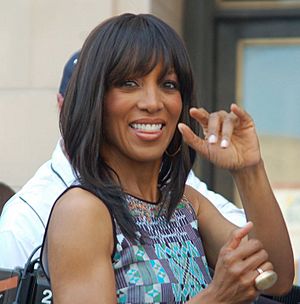
One local talk show, Strictly Speaking, became very popular. Shaun Robinson started as a reporter and then hosted Strictly Speaking. She was sometimes called "our own Oprah". Robinson later moved to another station.
In 1992, many employees voted to form a union. They said working conditions were unfair. The news department was later closed, and employees were laid off. Former employees believed this was because of their union activities. The station's license renewal was also delayed because it did not meet children's programming standards.
CBS Takes Over
A New Home for CBS
In 1994, a big change happened in TV. Fox outbid CBS for football game rights. This meant many CBS stations, including WJBK-TV in Detroit, switched to Fox. CBS needed a new station in Detroit. They tried to get other stations, but it did not work out.
CBS finally found a home in WGPR-TV. On September 23, 1994, CBS announced it would buy WGPR-TV for $24 million. This purchase meant 140 new jobs and upgrades for the station. It also saved the station from being removed from cable systems in Canada. Many people were surprised because WGPR-TV was not well-known outside the city.
On December 11, 1994, WGPR-TV became the new CBS station in Detroit. CBS spent a lot of money promoting the change. However, the switch caused some problems. Some cable viewers could not see the station clearly. Also, WGPR-TV's existing local shows, like The New Dance Show and Arab Voice of Detroit, were removed. The religious programs also disappeared.
Becoming WWJ-TV

The FCC approved the sale of WGPR-TV to CBS on July 24, 1995. CBS also kept its two Detroit radio stations, WWJ (AM) and WYST (FM). The station's call letters were changed to WWJ-TV on September 20, 1995. This brought the WWJ name back to Detroit television.
CBS faced many challenges to make WWJ-TV competitive. The station's signal was not strong enough for a major network. In 1997, CBS built a new, taller transmitter tower in Oak Park. This allowed WWJ-TV to reach more areas. The new facility also allowed the station to start digital television broadcasts in 1999.
CBS tried to start a news department for WWJ-TV in 1995. They hired a news director, but the plans were put on hold. WWJ-TV mostly showed a weekly newsmagazine called In Depth Detroit. By 1999, WWJ-TV was one of the few network-owned stations without a full news operation.
Merging with WKBD-TV
Viacom, which owned WKBD-TV, bought CBS in 1999. This allowed the two stations to work together. WKBD-TV was a larger station with its own news department. People criticized WWJ-TV for being just a "CBS relay transmitter".
In 2001, WKBD started producing an 11 p.m. newscast for WWJ-TV. It used WKBD's news team. The newscast promised "tonight's local news, straight to the point". However, it did not get many viewers. In 2002, the newscast was canceled. WWJ-TV then aired reruns of Everybody Loves Raymond instead.
In 2008, the station changed its branding to "WWJ-TV". It started showing local weather updates called "First Forecast". In 2009, these forecasts expanded into a two-hour morning show, First Forecast Mornings. This show ended in 2012. After that, WWJ-TV's local programming included "Eye on Detroit" segments and a public affairs program called Michigan Matters.
In 2017, WWJ radio separated from WWJ-TV. CBS kept the rights to the "WWJ" name for the TV station.
CBS News Detroit
On December 14, 2021, WWJ-TV/WKBD's parent company announced a new, full news service. It was called CBS News Detroit. This service would focus on online streaming news. It would also simulcast some hours on WWJ-TV. This means the same news would be shown on both the streaming service and the TV channel.
CBS News Detroit produces many hours of online streaming news each week. About 40 of those hours are also shown on WWJ-TV. Reporters are assigned to different communities. They have special vehicles with editing systems. This allows them to create reports without returning to the studio. The newsroom itself is also designed to be the news set.
Paul Pytlowany was named the first news director in January 2022. The station hired new on-air talent. This included Amyre Makupson's daughter, also named Amyre. She became an executive producer. Ronnie Duncan, a veteran broadcaster, became the lead sports anchor. His son, Jericka Duncan, is a CBS News correspondent.
On September 1, 2022, WWJ-TV changed its branding to "CBS Detroit". This was in preparation for CBS News Detroit's launch. The new weeknight newscasts started on January 23, 2023. Additional local news shows for morning, midday, and afternoon followed. For example, the morning newscast launched early on February 20, 2023, to cover a shooting at Michigan State University.
WWJ-TV also produces Michigan Matters. This weekly show discusses issues important to Detroit. It airs on Sunday mornings and is rebroadcast on CBS News Detroit.
Technical Information
Subchannels
WWJ-TV's signal is split into several channels:
| Channel | Res. | Aspect | Short name | Programming |
|---|---|---|---|---|
| 62.1 | 1080i | 16:9 | WWJ-HD | CBS |
| 62.2 | 480i | StartTV | Start TV | |
| 62.3 | DABL | Dabl | ||
| 62.4 | FAVE TV | Fave TV | ||
| 62.5 | Story | Story Television |
Digital TV Transition
WWJ-TV started broadcasting a digital signal in 1999. Its analog broadcasts on channel 62 ended on June 12, 2009. This was part of the big change to digital television in the United States. On March 13, 2020, the station moved its digital signal from channel 44 to channel 21.
In 2020, WWJ became one of five Detroit stations to use ATSC 3.0 (Next Gen TV). This is a newer way to broadcast TV signals.
Images for kids
See also


